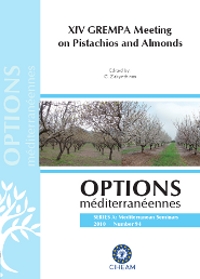| Article précédent | p. 153-157 | Article suivant |
Disruption of megagametophyte development caused by inbreeding in almond
A homozygous self-compatible almond with a high level of inbreeding producing a reasonable yield when cross-pollinated was experimentally found to drop fruits when self-pollinated. The aim of this work was to elucidate the causes of fruit abortion after selfing by studying pollen tube growth, megagametophyte development and fruit set following controlled self and cross-pollinations. Pollen tubes reached the ovary for both pollinations, however, differences were observed for embryo and endosperm development. Thus, while for cross-pollination a developing embryo and an incipient endosperm were observed, in self-fertilized ovules a degenerating embryo was observed in most cases. Thirty days after pollination, the percentage of fruit set was similar for both pollination types. In contrast, 60 days after self-pollination fruit set was very low or nil. These results indicate that the abnormal development of the megagametophyte in this genotype seems to be an expression of the high level of inbreeding.
Dans le cadre d'autofécondations contrôlées, des chutes de fruits ont été observées sur un amandier auto-compatible homozygote possédant un haut niveau de consanguinité et produisant un rendement raisonnable en pollinisation croisée. Le but de ce travail était d'élucider les causes d'avortement de fruits après autofécondation en étudiant la croissance des tubes polliniques, le développement du mégagamétophyte et des fruits issus de pollinisations croisées et d'autofécondations. Pour les deux types de pollinisations, les tubes polliniques ont atteint l'ovaire. Cependant, des différences ont été observées concernant le développement de l'embryon et de l'endosperme. Dans le cas de la pollinisation croisée, l'embryon et l'endosperme se développent, alors que dans la plupart des cas, un embryon dégénérescent a été observé pour les ovules auto-pollinisés. Trente jours après la pollinisation, le pourcentage de fruits était semblable dans les deux cas. Au contraire, après 60 jours, le nombre de fruits issus d'autofécondation était très bas ou nul. Pour ce génotype, ces résultats indiquent que le développement incorrect du mégagamétophyte semble être une expression de son haut niveau de consanguinité.
- [ Afficher ]
- [ Télécharger ]
- [ Exporter la citation ]
Vous pouvez télécharger la citation au format :
- [ Imprimer ]
-
Mots-clés
AUTOFECONDATION FORCEE, DEVELOPPEMENT BIOLOGIQUE, FRUCTIFICATION, PRUNUS DULCIS, TUBE DU POLLENCiter cet article
Ortega E., Martínez-García P.J., Egea J., Dicenta F. Disruption of megagametophyte development caused by inbreeding in almond. In : Zakynthinos G. (ed.). XIV GREMPA Meeting on Pistachios and Almonds. Zaragoza : CIHEAM / FAO / AUA / TEI Kalamatas / NAGREF, 2010. p. 153-157. (Options Méditerranéennes : Série A. Séminaires Méditerranéens; n. 94). 14. GREMPA Meeting on Pistachios and Almonds, 2008/03/30-2008/04/04, Athens (Greece). http://om.ciheam.org/om/pdf/a94/00801299.pdf



